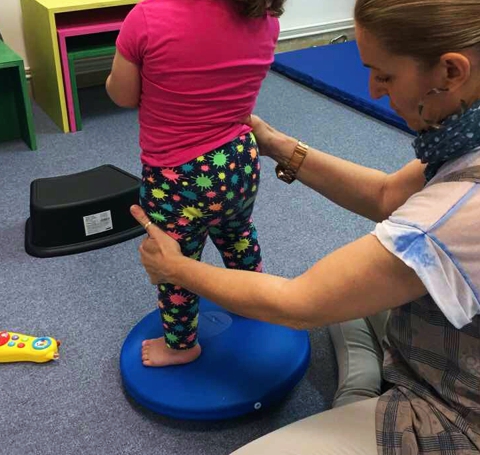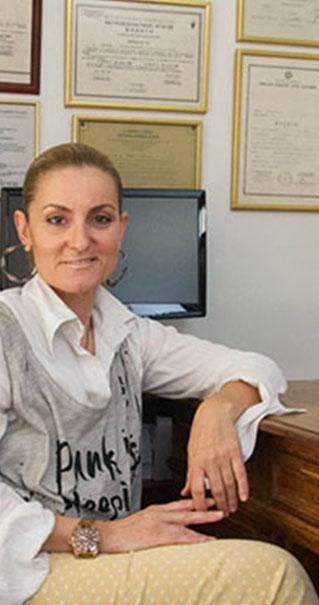What is plagiocephaly?
Plagiocephaly is a diagonal asymmetry in head’s shape. So it is also often to see some facial asymmetry in most of the cases.
Plagiocephaly is also known as deformational or positional plagiocephaly, or flat head syndrome.
Plagiocephaly develops when the infant’s skull, in very early age, becomes flattened in one area. This happens due to repeated pressure on one part of the skull or due to a difficult birth. In some cases, the pressure is caused by the position inside the amniotic sac.
There are 7 sacral bones which are soft, thin and flexible in very early age of life. This means that the heads of newborns can change shape easily. In cases where the pressure is asymmetrical in one spot can often create an asymmetrical distortion, a flattering of one side of the skull, which is often treatable. Also, it must be known that baby is in no pain at all. Studies have shown that nearly half of all infants aged 7 to 12 weeks had plagiocephaly. Of those, 78 percent had a mild form.
The shape of the infant’s head has a flat spot on the back of one side of the head probably also caused by remaining in a supine position for long time during the day or and the night.
The name of plagiocephaly is from ancient Greek πλάγιος (plagios) ‘oblique, slanting’, from plag– ‘flat, spread’, and from modern Latin cephal- ‘head, skull, brain’, (from Greek κεφαλή) together meaning ‘flat head’.
Types of plagiocephaly
Cranio-Synostosis is often involved with plagiocephaly and it is a rare genetic defect that causes the plates on a baby’s skull to fuse prematurely. Weather is synostosis involved or not, there are two types of flat head syndrome:
-
Synostotic, with one or more fused cranial sutures
-
Non-synostotic which is a deformational of the skull
Brachycephaly describes a very wide head shape with a flattering across the whole back of the head.
In cases where a premature union of skull bones occurs, giving a “diamond” shaped head, is more properly called craniosynostosis.
Torticolis is related with congenital muscular tightness and stiffness in the neck area, restricting head’s baby movement.
Plagiocephaly can be mild, moderate or severe.
Mild plagiocephaly is head’s baby measured and has Cephalic Ratio of 91 to 93 mm and the cranial vault asymmetry of 5 to 9 mm.
In 77% of cases milder plagiocephaly can be corrected sufficiently without the need of a helmet which is known as repositioning.
Causes of plagiocephaly
Plagiocephaly is diagnosed at birth and may be the result of:
-
A restrictive intrauterine environment, as already mentioned,
-
Recommendations of anti-sudden infant death syndrome, for parents to keep their babies on their backs has increased the incidence of plagiocephaly dramatically.
Data also suggest that the rates of plagiocephaly are higher:
-
for twins and multiple births,
-
premature babies,
-
babies who were positioned in the breech position or on their back,
-
babies born after a prolonged labor,
-
babies who have been squashed due passage down the birth canal* infant’s skull is like a set of shifting puzzle pieces that allow the head to grow, and these malleable plates are great at protecting the developing brain, but it can flatten when the baby is placed down on his back.
-
in some babies, more severe plagiocephaly can be caused by tight neck muscles (congenital muscular torticollis), which means babies have a strong preference for turning their heads to one side.
An assessment evaluation of physical and functional development is recommended in any case of plagiocephaly or any other deformity.
Signs and symptoms of plagiocephaly
Babies with plagiocephaly usually show some common signs and symptoms.
The most common signs are:
-
an uneven shape of their head
-
a flat head area
-
a flattened posterior or side section of the head
-
the ears might look uneven to each other
-
forehead might be more prominent compared to the rest of the head
-
In cases like synostosis the baby’s skulls bones don’t close properly
-
It is common for an infant with positional plagiocephaly to have misaligned ears. In this situation the ear of the affected side may be pulled forward and down and be larger or stick out more than the unaffected ear.
In case that your baby struggles with some of the following:
-
the shape of the baby’s skull hasn’t gone back to a normal shape by the age of two to three months old,
-
the child has strong preference to one side of his head
-
has difficulties to turn his head on both sides
-
have difficulties to spend time on his tummy
-
developmental delays in gross motor skills like rolling, crawling etc.
maybe it’s time to see a doctor or a specialized pediatric physiotherapist to get some recommendations about his developmental procedure.
What to expect when your child has plagiocephaly?
Prevention methods include carrying the infant and giving it time to be on his tummy, which prevents plagiocephaly from progressing from mild to moderate or severe.
Early intervention, normally based on the type, is important to prevent and reduce the severity or the degree of the plagiocephaly.
Preliminary research indicates that developmental difficulties or delays can occur in some babies with plagiocephaly or any other skull deformity. Plagiocephaly is associated with motor and language developmental delays. While developmental delays are more common among babies with plagiocephaly, it’s not always clear that this is the cause of the delay.
Plagiocephaly often doesn’t need treatment but it seems like it can auto-heal as your baby grows. Normally this happens because infant’s head shape will naturally improve as,
-the skull changes shape during growth,
-the baby spends more time at his tummy instead of on his back and,
-the gross motor function allows the baby to spend more time in positions other than supine.
However, we don’t know at first exactly how the child’s developmental procedure will be and secondly if he will adapt to his age milestones. Therefore, the simple recommendations about plagiocephaly could help the infant’s development and might prevent serious effects.
It is always preferred that parents visit a specialized pediatric physiotherapist or a doctor instead of waiting and seeing how is the baby’s growth. But in case that they haven’t seen already a therapist there are some indications that might help the baby’s developmental gross motor function.
How can we treat plagiocephaly?
The course of treatment is usually based on the age of the child, the severity of the condition and the type of plagiocephaly (mild, moderate or severe).
In the following section, I will refer to the common recommendations that will help parents find some guidelines for the first period of their baby’s life.
-
Treatment usually includes the reduction of the pressure of the affected area through the baby’s repositioning on their abdomen for extended periods of time throughout the day
-
The repositioning of the child’s head throughout the day might help so that the rounded side of the head is placed against the mattress
-
Re-positioning cribs and other areas that the baby spends time in, might be a nice way to force him to look at different directions to see his parents or other persons or other materials like toys in the room
-
Re-positioning furniture and other toys for similar reasons
-
Avoiding extended periods of time sleeping in car-seats, except of course, when the baby is actually in the vehicle
-
Avoiding bouncy seats or any other supine sitting products which could intensify the problem or cause discomfort or crying to the child when is re-positioned
-
Crawling may also be crucial in preventing plagiocephaly as it strengthens the babies’ spine and neck muscles and also boosts gross and fine motor skills, balance, hand-eye-coordination and overall strength
-
In some cases, and only if this isn’t inconvenient for the baby’s sleeping time, is recommended to change head’s position from right to left and vice versa
-
When the baby is awake let him spend tummy time under supervision
-
During the day the baby must have the opportunity to play on his side in order to develop the eye-hand coordination
-
In the cot or on the change table, alternate the end that the baby is placed on
-
Talk to the baby, or place a toy, or shake a rattle, from his less favorite side and with this trick it will encourage him to turn more his head to that side
-
The recommendations about face up sleeping time to reduce the risk of Sudden Infant Death Syndrome(SIDS), is something that mustn’t upset the parents, instead they can spend a lot of tummy time with their babies during the day
-
Simple and gentle stretching exercises it might improve the baby’s neck mobility
-
There are some recommendations about how parents and caregivers must curry and handle their babies and that depends on the type and the severity of plagiocephaly, but is always very helpful to be aware of
-
The position’s variety is the key for motor and cognitive development
-
During feeding time, the baby must be placed on his side either way
-
If the diagnosis is determined to be severe, practitioners will likely prescribe a cranial molding orthosis (helmet), which has the best results when prescribed between five to six months of age.
-
It must be said that there isn’t any recommendation in any case to take your baby to a chiropractor for back or neck adjustments.
Diagnosis is most commonly determined through clinical examination by the pediatrician or the specialized pediatric physiotherapist. In order to assess the severity of the condition and determine the best course of treatment, practitioners often use the Plagiocephaly Severity Scale which is a standardized scale evaluation.
When does plagiocephaly go away?
Plagiocephaly usually is noticed between the ages of 6 weeks and 2 months old. This might be resolved completely by the age of two years old:
-in cases that parents get some help from a pediatric physiotherapist or
-in other cases where particularly parents and caregivers regularly work on varying baby’s positions when he’s awake.
Either way that depends on the condition of the plagiocephaly, the severity, the age of the baby and of course by the doctor’s orders. Usually, the baby’s growth is normal in most cases.
Plagiocephaly syndrome can be disconcerting, especially for new parents, but it rarely causes any harm to the baby and usually remedies itself within a few months.
Parents must live the babyhood even if there is some signs of plagiocephaly because this age will be gone before they know it.
When treatment starts at the optimum age of 3-6 months, it can usually be completed within 12 weeks. Correction is still possible in babies up to age 18 months, but will take longer.
The decision to give the baby plagiocephaly treatment or to use helmet, is not the parent’s but the pediatrician’s or the pediatric physiotherapists’ to make. Otherwise, it can only cause huge anxiety and stress of what might happen in the baby’s development process.
Parents must have confidence to pediatricians and physiotherapists who are specialized to give the best results in every case that is needed.
Remember with Physio you can only be better.

